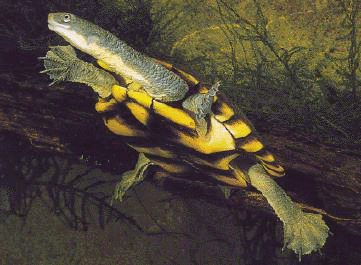Eastern Long Neck Turtle -- Chelodina longicollis
by Scott Thomson.
 Probably the most commonly kept species of Chelodina this is a species with a complex life history making it more challenging to keep properly than it first appears. I have already published a Chelodina longicollis care sheet on the World Chelonian Trust website so will not go into a lot of repitition here. I will go over some of the more interesting facets of the species natural history though so people can draw their own conclusions as to why it is a difficult species to keep.
Probably the most commonly kept species of Chelodina this is a species with a complex life history making it more challenging to keep properly than it first appears. I have already published a Chelodina longicollis care sheet on the World Chelonian Trust website so will not go into a lot of repitition here. I will go over some of the more interesting facets of the species natural history though so people can draw their own conclusions as to why it is a difficult species to keep.
This species is probably Australia's most terrestrial turtle in that it is known to spend many months of a year on land moving between lakes and waterholes, a process dependant on the weather. For the most part and under favorable conditions the species lives in temporary waterholes that are high in aquatic insect life and rich in nutrient. Under this regime the turtle will grow rapidly, breed and stay put.
Then comes the inevitable drought in Australia. The temporary waterholes dry up and the species moves to permanent waterholes and lakes to ride out the drought. These envionments are low in nutrient, low in aquatic insects and hence the turtles do not grow, probably do not breed and just stay put waiting. This can go on for years as drought is not only common in Australia but it tends to be protracted These two facets of the turtles life were drawn out by Arthur Georges and his students at the Jervis Bay study site. Projects there I also had the opportunity to join in on.
In between these of course the turtle is travelling, they travel from temporary water to permanent, and back again. They may spend a long time on land and really do know where they are going. They seem to use a combination of the sun and their sense of smell to guide them as was discovered by Terry Graham in his trips to Australia. They are also very adept at obtaining water on land and seem to obtain water from condensation on their head. This was the end result of work by Sharon Kilgour (Honours Student of Arthur Georges).
Another surprise to many people is just how far they go on land. Rod Kennett began a study in 1983 which has culminated in the routine tracking of around 2000 turtles now for the last 20 years. A number of drought events have occured in this time. Turtles are found up to 7km from their previous capture points. A last myth to dispell is that the species is quite capable of eating on land having been found with terrestrial insects in their stomach contents and one sighting of an Eastern Long Neck feasting on a roadkill Kangaroo.
So this species with its complicated life history is not as simple as it looks. Hence the caresheet tries to address some of the requirements of the species.
